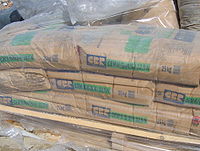
Photo from wikipedia
Abstract One of the most important industries and building operations that cause carbon dioxide emissions is the cement and concrete-related industries that consume about 6 million Btus per metric ton… Click to show full abstract
Abstract One of the most important industries and building operations that cause carbon dioxide emissions is the cement and concrete-related industries that consume about 6 million Btus per metric ton and release about 1 metric ton CO2. Reducing cement consumption while using nanomaterials as cement replacement is favored for environmental protection reasons. In this study, the effect of nanoclay (NC) as an additive to the cement paste was evaluated and quantified. Scanning Electronic Microscope (SEM), X-ray diffraction (XRD), Thermogravimetric Analysis (TGA), Fourier-Transform Infrared Spectroscopy (FTIR), and Raman Spectroscopy analysis were used to identify the cement and nanoclay. Experimental tests and modeling were conducted to predict the cement paste's flow properties like yield stress, shear strength (shear stress limit), viscosity, and stress at the failure stress of cement paste. The cement paste modified with nanoclay was tested at a water-to-cement ratio (w/c) of 0.35 and 0.45 and temperatures ranging from 25⁰C to 75⁰C. The addition of NC increased the ultimate shear strength (τmax) and the yield stress (τo) from 22.5% to 54.4% and from 26.3% to 203%, respectively based on the NC content, w/c, and temperature. TGA tests showed that the 1% nanoclay additive reduces the weight loss of the cement at 800⁰C by 74% due to the interaction with the nanoclay with the cement paste. The nonlinear regressions model (NLR), and Artificial Neural Network (ANN) technical approaches were used for the qualifications of the flow of slurry and stress at the failure of the cement paste modified with nanoclay. Based on the static analysis assessments, the rheological properties and compressive strength of cement paste modified with nanoclay can be well predicted in terms of w/c, nanoclay content, temperature, and curing time using two different simulation techniques. Among the used approaches and based on the experimental data set, the model made based on the NLR models is the most reliable model to predict rheological properties and compression strength of the cement and it is performing better than the ANN model. The coefficient of the correlation (R), mean absolute error (MAE), and root mean square error (RMSE) concluded that the nanoclay content is the most important parameter for rheological estimation and compression strength of cement paste.
Journal Title: Ain Shams Engineering Journal
Year Published: 2020
Link to full text (if available)
Share on Social Media: Sign Up to like & get
recommendations!